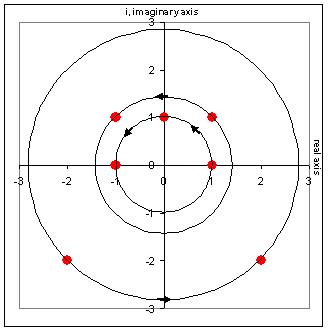Now adding complex numbers is easy. Just add the real numbers together and the imaginary numbers together. For example, the generalized case goes as follows:
(a + bi) + (c + di) = (a+c) + (b+d)iSimple. Subtraction works similarly.
Now let's look at multiplication. Imagine some point a + bi on our complex plane. What happens if we multiply it by another complex numbers? Mathematically we just use the commutative principle to get the answer.
(a + bi) * (c + di) = ac + adi + bic + bdi2Fairly straight forward. Division is not intuitive but clearly when multiplied by the denominator has to give the numerator. And so working back from this fact you can generate shorthand rules for doing this operation.
simplifying we get
(ac - bd) + (ad + bc)i
But what is exactly going on here graphically?
Let's restrict ourselves to multiplying by a real number first. Let's multiply by 1. Graphically nothing happens. ( a + bi)1 = a + bi. Our original points stays where it is. Let's try multiplying by 2. We now have 2a + 2bi. What has this done to our point on the plane? Well it's moved our original point out away form the origin (O). If you consider a number of different points -1, -2-2i, 3i, 2+6i and where they move to (-2, -4-4i, 6i, 4+12i) the graphical effect is an expansion. We have expanded (or we can contract) the original points outward away from (or toward) the origin.
Let's just multiply a number by i to simplify things. Consider a number of points (1, i, 1+i, -2-2i). These 4 points move to (i, -1, -1+i, 2-2i) when we multiply by i. Let's take the first number, 1. That multiplies by i and becomes i. Think about this graphically on our complex plane. It's gone from 1 to i. It could have gone there in a straight line (diagonal to our axes) but if we consider all other points and how they behave when we multiply by i we realize that 1 goes to i by a rotation counterclockwise. And a rotation of exactly 90 degrees. i rotates whatever point it is acting on, around the origin by 90 degrees. 1 rotates to i. i rotates to -1. 1+i (a point at 45 degrees to the x-axis) rotates to -1+i (a point 135 degrees to the x-axis) and -2-2i (a point -135 degrees to the x-axis) rotates to 2-i (a point -45 degrees to the x-axis). This is shown below.

In short we can imagine i operating on 1 many times and slowly rotating it around the unit circle.
i * 1 = i (90° rotation)Multiply 1 by i, 4 times, and it takes us back to 1. We've circled around the complex plane. Division will work the same way but rotate in the opposite direction.
i * i = -1 (180° total rotation)
i * -1 = -i (270° total rotation)
i * -i = 1 (360° total rotation)
Now you might be able to guess how we can generalize multiplication now for complex numbers - those numbers with both real (causes expansion) and imaginary (causes rotation) components. Take any number z and multiply by another number z' and the answer, located on the complex plane, will in general be found by performing both a rotation and an expansion (or contraction) on the original point. It's tough to diagram but think of a spiral galaxy to get some idea of the kind of graphical movement a point undergoes when being multiplied by a complex number.
Now let's change our point of reference. When we plot z on our complex plane, we effectively are representing the complex number z in an (x,y) form. a = x and bi = y. Another way to describe the point z in 2 dimensions is to use circular coordinates. Rather than specifying the ordinate (x) and the abscissa (y) we specify the radius (r) from the origin and the angle (θ) from the positive x axis) that the point z makes. We use some standard equations to do this.
r = (x2 + y2)(1/2)r here is known as a modulus. and θ is called the argument. r here is obtained by the Pythagorean Theorem (r is hypotenuse of a triangle) and θ is the angle. When we multiply two complex numbers together what are doing is multiplying the moduli (r) and adding the arguments(θ). Let's test this out with an easy case,
tan(θ) = y/x or θ = arctan(y/x)
i * 1Since this is such a simple set of numbers it's easy for us to calculate the moduli and arguments. For i, the modulus is 1, and the argument is 90°. For 1, the modulus is 1 again, and the argument is 0 degrees. If you don't understand this visualize where these two numbers are on our complex plane. They both reside on the unit circle so they both have radius or modulus 1. The only difference between the two is the angle they make with the positive x-axis. So let's carry out our multiplication rule.
Add arguments = 90° + 0° = 90°The complex number with modulus 1 and argument 90° is of course i. And this is correct because we know this intuitively that 1 * i = i. So we cansee graphically that adding our arguments is our 'rotation' and multiplying our moduli is our 'expansion/contraction'.
Multiply moduli = 1 * 1 = 1
Okay we're set to climb up the math ladder to discuss logs and exponents next.

No comments:
Post a Comment